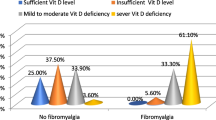Abstract
The etiology and pathogenic mechanisms of fibromyalgia (FM) syndrome are unknown. A number of studies have shown that there is an association between some of the musculoskeletal system diseases and hyperlipidemia. The aims of this study were (1) to compare the serum lipid profile among FM and healthy women and (2) to investigate the relationship between serum lipid levels and FM findings. One hundred sixty-four women (82 women with FM as study group and 82 healthy women as control group) were enrolled in the study. The mean serum total cholesterol and low-density lipoprotein cholesterol (LDL-c) were found significantly higher in the FM group than that in the control group (p<0.05). However, There was no statistically significant difference in the mean serum triglyceride, high-density lipoprotein cholesterol (HDL-c), and very low-density lipoprotein cholesterol (VLDL-c) values between the two groups (p>0.05). In the FM group, we could not find a significant correlation between the serum lipid profile values and the FM parameters (p>0.05).
Similar content being viewed by others
References
Bernatsky S, Dobkin PL, De Civita M, Penrod JR (2005) Co-morbidity and physician use in fibromyalgia. Swiss Med Wkly 135:76–81
McCarberg B, Barkin RL, Wright JA, Cronan TA, Groessl E, Schmidt SM (2003) Tender points as predictors of distress and the pharmacologic management of fibromyalgia syndrome. Am J Ther 10:176–192
Wolfe F, Ross K, Anderson J, Russell IJ, Hebert L (1995) The prevalence and characteristics of fibromyalgia in the general population. Arthritis Rheum 38:19–28
White KP, Speechley M, Harth M, Ostbye T (1999) The London Fibromyalgia Epidemiology Study: the prevalence of fibromyalgia syndrome in London, Ontario. J Rheumatol 26:1570–1576
Alarcon GS, Bradley LA (1998) Advances in the treatment of fibromyalgia: current status and future directions. Am J Med Sci 315:397–404
Rossy LA, Buckelew SP, Dorr N, Hagglund KJ, Thayer JF, McIntosh MJ, Hewett JE, Johnson JC (1999) A meta-analysis of fibromyalgia treatment interventions. Ann Behav Med 21:180–191
Thomas E, Blotman F (2002) Are antidepressants effective in fibromyalgia? Joint Bone Spine 69:531–533
Cedraschi C, Desmeules J, Rapiti E, Baumgartner E, Cohen P, Finckh A, Allaz AF, Vischer TL (2004) Fibromyalgia: a randomised, controlled trial of a treatment programme based on self management. Ann Rheum Dis 63:290–296
Klemp P, Halland AM, Majoos FL, Steyn K (1993) Musculoskeletal manifestations in hyperlipidemia: a controlled study. Ann Rheum Dis 52:44–48
Careless DJ, Cohen MG (1993) Rheumatic manifestations of hyperlipidemia and antihyperlipidemia drug therapy. Semin Arthritis Rheum 23:90–98
Struthers GR, Scott DL, Bacon PA, Walton KW (1983) Musculoskeletal disorders in patients with hyperlipidemia. Ann Rheum Dis 42:519–523
Wolfe F, Smythe HA, Yunus MB, Bennett RM, Bombardier C, Goldenberg DL, Tugwell P, Campbell SM, Abeles M, Clark P (1990) The American College of Rheumatology 1990 criteria for the classification of fibromyalgia. Report of the Multicenter Criteria Committee. Arthritis Rheum 33:160–172
Burkhardt CS, Clark SR, Bennett RM (1991) The Fibromyalgia Impact Questionnaire: development and validation. J Rheumatol 18:728–733
Hedin PJ, Hamme M, Burkhardt CS, Engstrom-Laurent A (1995) The Fibromyalgia Impact Questionnaire, a Swedish translation of a new tool for evaluation of the fibromyalgia patient. Scand J Rheumatol 24:69–75
Buskila D, Neumann L (1996) Assessing functional disability and health status of women with fibromyalgia: validation of a Hebrew version of the Fibromyalgia Impact Questionnaire. J Rheumatol 23:903–906
Offenbaecher M, Waltz M, Schoeps P (2000) Validation of a German version of the Fibromyalgia Impact Questionnaire (FIQ-G). J Rheumatol 27:1984–1988
Sarmer S, Ergin S, Yavuzer G (2000) The validity and reliability of the Turkish version of the Fibromyalgia Impact Questionnaire. Rheumatol Int 20:9–12
Ozgocmen S, Ardicoglu O (2000) Lipid profile in patients with fibromyalgia and myofascial pain syndromes. Yonsei Med J 41:541–545
Hacettepe University Institute of Population Studies (2004), General Directorate of Mother and Child Health/Family Planning. Ministry of Health, Ankara, Turkey, p 65
Keel P (1999) Pain management strategies and team approach. Baillieres Best Pract Res Clin Rheumatol 13:493–506
Sim J, Adams N (1999) Physical and other non-pharmacological interventions for fibromyalgia. Baillieres Best Pract Res Clin Rheumatol 13:507–523
Oliver K, Cronan T (2002) Predictors of exercise behaviors among fibromyalgia patients. Prev Med 35:383–389
Bennett RM, Clark SR, Goldberg L, Nelson D, Bonafede RP, Porter J, Specht D (1989) Aerobic fitness in patients with fibrositis. A controlled study of respiratory gas exchange and 133xenon clearance from exercising muscle. Arthritis Rheum 32:454–460
Aguilo A, Tauler P, Pilar Guix M, Villa G, Cordova A, Tur JA, Pons A (2003) Effect of exercise intensity and training on antioxidants and cholesterol profile in cyclists. J Nutr Biochem 14:319–325
Hardman AE (1996) Exercise in the prevention of atherosclerotic, metabolic and hypertensive diseases: a review. J Sports Sci 14:201–218
Wood PD (1994) Physical activity, diet, and health: independent and interactive effects. Med Sci Sports Exerc 26:838–843
Brites FD, Evelson PA, Christiansen MG, Nicol MF, Basílico MJ, Wikinski RW, Llesuy SF (1999) Soccer players under regular training show oxidative stress but an improved plasma antioxidant status. Clin Sci 96:381–385
Author information
Authors and Affiliations
Corresponding author
Rights and permissions
About this article
Cite this article
Gurer, G., Sendur, O.F. & Ay, C. Serum lipid profile in fibromyalgia women. Clin Rheumatol 25, 300–303 (2006). https://doi.org/10.1007/s10067-005-0004-5
Received:
Revised:
Accepted:
Published:
Issue Date:
DOI: https://doi.org/10.1007/s10067-005-0004-5




